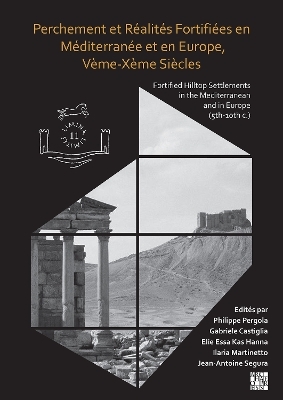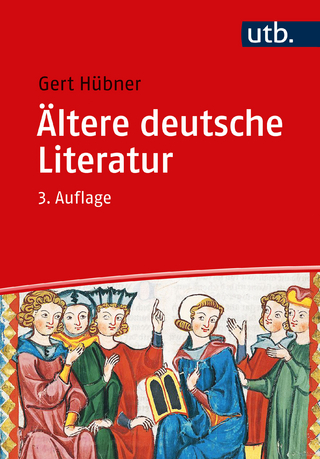
Perchement Et Realites Fortifiees En Mediterranee Et En Europe, Veme-Xeme Siecles
Archaeopress (Verlag)
978-1-80327-241-2 (ISBN)
Perchement et Réalités Fortifiées en Mediterranee et en Europe, Vème-Xème Siècles / Fortified Hilltop Settlements in the Mediterranean and in Europe (5th-10th centuries) is the result of the International Congress held in October 2019 in Roquebrune-sur-Argens about the fortified hilltop settlements of Late Antiquity and the Early Middle Ages. The congress brought together many of the most prominent scholars in the field (principally archaeologists) to present both brand new data and syntheses on wide contexts throughout the European continent, the Mediterranean basin and beyond. The book stands as the most recent and comprehensive update on the ‘perchement’ (i.e. the fortified hilltop settlement) and it will represent a benchmark for scholars working on this topic for decades to come.
Philippe Pergola is Full Professor and Dean at the Pontificio Istituto di Archeologia Cristiana (Rome) and Professor Emeritus at the University of Nice. His main research interests deal with the Early Christian topography of cities and rural areas in the Mediterranean. He has directed more than 150 archaeological missions in the Mediterranean and in the Horn of Africa and has authored hundreds of publications on these topics. Gabriele Castiglia gained his PhD from the Pontificio Istiuto di Archeologia Cristiana (Rome) where he is Assistant Professor. He has worked for twenty years in archaeological missions in Italy and in Eastern Africa and has authored many publications on these topics. Elie Essa Kas Hanna began his university studies in Syria, where he completed a master's degree in archaeology at the University of Aleppo in 2007. He obtained his PhD from the Pontifical Institute of Christian Archaeology in Rome in 2017, and is currently visiting professor at the Pontifical Oriental Institute, Rome. Ilaria Martinetto is an independent researcher. Jean-Antoine Segura (Université de Caen Normandie) completed a masters in archaeology at the University of Aix-en-Provence and is currently a PhD candidate in medieval archaeology at the University of Caen Normandy (CRAHAM lab). His research focuses on early medieval fortifications (5th-9th c. A.D.)
Préface – Xavier Delestre ;
Introduction aux actes: Le Perchement, genèse d’un Congrès international – Bilan et enjeux scientifiques – Philippe Pergola ;
Séance d’ouverture / Opening session ;
Discours d’introduction – Danilo Mazzoleni ;
Pillage et destruction du patrimoine archéologique :le droit à l’épreuve d’une menace sans frontières – Roland Defendini ;
ANGKOR – Site du Patrimoine Mondial depuis 1992 – Mounir Bouchenaki ;
Session 1: D’un monde à l’autre. Évolution des cadres géopolitiques des Pyrénées basques et catalanes aux alpes orientales et bilan des connaissances sur le perchement en rapport avec l’habitat / From one world to another. Evolution of geopolitical frameworks from the Basque and Catalan Pyrenees to the Eastern Alps and assessment of knowledge on perching in relation to habitat ;
Le cadre historique, institutionnel et commercial des alpes de la mer aux Pyrénées sources textuelles et données archéologiques ;
Ships and Islamic products discovered of the Provençal coast.Physical evidence of the trade in
the western Mediterranean Sea (end of 9th-10th C.AD)– Catherine Richarté-Manfredi ;
Commerces et échanges ;
Observations on networks and the supply of Byzantine centres, forts, outposts and redoubts – Paul Arthur ;
Les Alpes de la mer et l’espace provençal (1ère partie) ;
Le premier Moyen Âge des Alpes-Maritimes (Ve-Xe siècles). Archéologie d’une couche (pas si) résiduelle – Fabien Blanc-Garidel ;
Les Alpes de la mer et l’espace provençal (2ème partie) ;
Aperçu sur l’archéologie en Provence-Alpes-Côte d’Azur (1959-2020) – Xavier Delestre ;
Approche toponymique du phénomène castral en Provence – Élisabeth Sauze ;
Les sites perchés de Provence aux Vème-Xème siècles: bilan et perspectives de recherche – Daniel Mouton, Jean-Antoine Segura et Mariacristina Varano ;
Bilan croisé sur deux sites perchés antiques tardifs, les Baux-de-Provence et l’oppidum Notre-Dame de Consolation à Jouques (Bouches-du-Rhône), au regard des recherches récentes sur
les établissements de hauteur – Caroline Michel d’Annoville (avec la collaboration de Claire Moreau) ;
Saint-Blaise, de l’agglomération tardo-antique au castrum médiéval: évolution d’un habitat de hauteur dans un contexte méditerranéen – Marie Valenciano ;
L’habitat perché du Malpas à Soyons (Ardèche) durant l’Antiquité tardive : état des données – Amaury Gilles, Pierre Dutreuil, Pierre Charrey, Stéphane Carrara, Aline Colombier-Gougouzian, Michel Feugère, Bastien Dubuis, Gaëlle Guillerme and Michaël Seigle ;
Déprise urbaine et dépeuplement à Fréjus. Entre abandon et continuité (IVe-VIIIe siècles) – Pierre Excoffon et Hélène Garcia (avec la collaboration de Fl. Grimaldi, Chr. La Rocca et E. Pellegrino) ;
Dynamique et trame du peuplement dans la région de Fréjus (Var, France) entre le Vème et
le VIIIème siècles de n. è. – Frédérique Bertoncello et Jean-Antoine Segura ;
Les Pyrénées et la péninsule ibérique ;
Power in tension: Fortifications between Local Aristocracies and States in the Ebro Valley during
the Early Medieval Ages – José María Tejado Sebastián ;
Los habitats « perchés » en la parte oriental de la Península Ibérica entre los siglos V y X – Albert Ribera i Lacomba ;
Fortificaciones altomedievales en torno a lugo (Galicia, España). Estudio arqueológico del yacimiento de o castelo de Rubiás – Irene García Losquiño, José Carlos Sánchez Pardo, Carlos Otero Vilariño, Jorge Sanjurjo Sánchez y Manuel Gago Mariño ;
A cidade portuária e a fortificação de Mértola entre a Antiguidade Tardia e a Islamização – Virgílio Lopes ;
La Méditerranée – l’Italie péninsulaire (1ère partie) ;
Le nuove dinamiche insediative dell’Italia bizantina e post bizantina (VI – X sec.) – Enrico Zanini ;
Popolamento e nuove dinamiche insediative del mondo rurale nell’Italia centro-settentrionale
(V-X sec.) – Marco Valenti ;
La dialettica tra insediamenti di altura e insediamenti di pianura tra Tardoantico e Medioevo nella
Puglia centro-settentrionale – Pasquale Favia e Giuliano Volpe ;
La sauvegarde du patrimoine archéologique détruit ou menacé : une urgence planétaire – Elie Essa Kas Hanna ;
La Méditerranée – l’Italie péninsulaire (2ème partie) ;
Lo sfruttamento delle alture e le fortificazioni nell’Italia nord occidentale (V-X secolo) – Gian Pietro Brogiolo ;
Insediamenti, cristianizzazione e migrazione di Popoli in Carnia tra IV e X secolo – Aurora Cagnana ;
Perchement, città e territorio nella Liguria occidentale – Gabriele Castiglia, Elie Essa Kas Hanna e Philippe Pergola ;
Session 2: Perchement et fortifications du monde rural en rapport avec villes et frontières / Perching and fortifications of the rural world in relation to towns and borders ;
La Méditerranée – îles et continents ;
Dopo i paesaggi delle ville: nuove dinamiche insediative e siti d’altura nel mondo rurale della Sicilia tardoantica, bizantina ed islamica (V – X/XI sec.) – Giuseppe Cacciaguerra e Angelo Castrorao Barba ;
Assetti urbani e fortificazioni a Cipro nella transizione fra Tarda Antichità e alto Medioevo – Luca Zavagno ;
Perching and fortified sites – Syrian-Palestinian cases – Basema Hamarneh ;
L’Adriatique et l’Europe centrale et orientale ;
Hilltop sites in Slovenia between the 5th-10th centuries – Tina Milavec ;
Le torri tardoantiche della Dalmatia a pianta rettangolare e quadrata – Josipa Baraka Perica ;
Castra ed edifici di culto cristiani : il caso della Dalmatia – Božana Maletić ;
Le réseau des fortifications dans l’arrière-pays bas-danubien tardo- antique : la Moesia Secunda et
la Scythia – Irina Achim et Dominic Moreau ;
Le réseau des fortifications dans l’arrière-pays bas- danubien tardo-antique : la Dacia Ripensis – Ivan Gargano et Dominic Moreau ;
Les sites perchés de Serbie durant l’Antiquité tardive – Vujadin Ivanišević ;
L’Europe du Nord ;
Hillforts in Southern Britain: Power and Place in the Late Antique Landscape – Andy Seaman ;
Early medieval hilltop and enclosed settlements of Scotland during the first millennium AD – Gordon Noble
| Erscheinungsdatum | 29.04.2023 |
|---|---|
| Verlagsort | Oxford |
| Sprache | französisch |
| Maße | 208 x 295 mm |
| Gewicht | 748 g |
| Themenwelt | Geisteswissenschaften ► Archäologie |
| Geschichte ► Allgemeine Geschichte ► Mittelalter | |
| ISBN-10 | 1-80327-241-4 / 1803272414 |
| ISBN-13 | 978-1-80327-241-2 / 9781803272412 |
| Zustand | Neuware |
| Haben Sie eine Frage zum Produkt? |
aus dem Bereich


